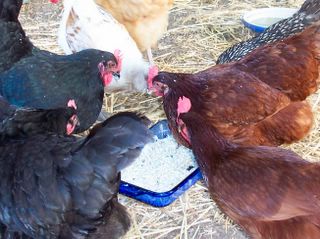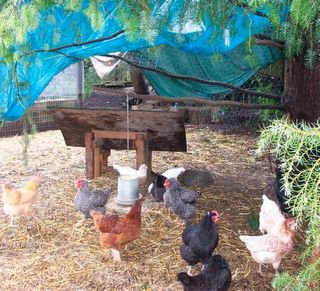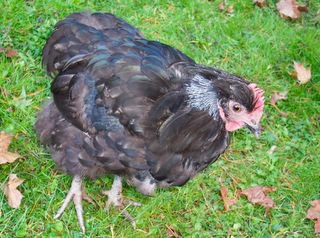
Here's an "action shot" of the hens enjoying my world famous Gourmet Mash. 9.5 out of 10 hens agree this is the meal of their lives!
The mash often consist of a small quantity of layer pellets with yogurt, cottage cheese or kefiili (like kefir, a cultured milk product) plus odds and ends of whatever is available. The cultured milk products are very, very good for helping chickens stay healthy.
This weekend I made an amazing gourmet mash which made the hens extremely happy, and wanted to share this recipe with you poultry enthusiasts. Since it involves meat, if you are a new visitor, please check the archives for my post on chickens as omnivores--other poultry enthusiasts have assured me they see the same dietary behavior in their flocks too! We don't often feed them meat, but it has a dramatic positive health benefit when we do. Consider adding meat to your mash recipe in the early spring to help boost immunity after a long winter, after an illness, and during a molt to help protein depleted birds (feathers are all protein). You can also omit the meat or other items from this mash and add your own ingredients.
Leann's Happy Hen Gourmet Mashfeeds a flock of 20 (with enough left over that everyone gets some)
1-2 pints yogurt or other cultured milk product
1 pint low-salt cottage cheese
2 pounds ground beef
1 bunch parsley
1 bunch lemon balm
1 head garlic
1-2 cups raw pumpkin seeds
1 pint baby tomatoes
enough pellet feed to make a mushy consistency
2-3 casserole type pans
Put all the pans on a counter or work space where you can evenly divide the ingredients between the 3 pans.
-Add the yogurt & cottage cheese
-Remove leaves from lemon balm and add to pans
-Take parsley, and using scissors, snip entire bunch into small pieces
-Put in ground beef, yes, raw
-Slice all tomatoes in half and add
Mix with hands, getting ground beef and cottage cheese thoroughly mixed
-Add a small quantity of pellets to mash, enough to make it thicken
-Peel most of paper husks off garlic cloves, and add cloves to Cuisinart
-Add pumpkin seeds to Cuisinart, and blend until both garlic and seeds are in bits
-Add this mixture to mash
Mix well, and serve (put the dishes in various parts of the run so all hens, low and high in terms of pecking order, can eat freely)
I don't always use all these ingredients, but a little about what the benefits are for your flock:
Cultured dairy products are as beneficial for hens as they are for humans. Cultured dairy is high in protein and calcium, and the friendly flora helps prevent diseases and parasites in a flock.
Meat, as I've already mentioned, can be an excellent periodic supplement to a flock diet. This is especially true after winter, illness, or a molt when a hen's protein needs increase dramatically. Additionally, according to the Weston Price Foundation, there are fat soluble vitamins and activators that only meat can provide. Since raw is better, put your meat in the freezer for 2 weeks prior to feeding to your birds, to kill any possible parasites, etc. Feel free to search the archive for a post about feeding raw deer liver to the flock--they loved it!
Lemon Balm is a powerful antiviral--our flock was exposed to viral poultry pox, which is sort of like human oral herpes in that it is non-fatal and they carry it for life. So for our flock, treating with lemon balm is a good thing.
Parsley is extremely high in minerals and vitamins. I've also been known to use granulate kelp and dulse.
Garlic is a potent antiviral, antifungal, antiparasitical, and antibacterial. Organic poultry farmers rave about use of garlic, and the mash is the best way I've found to get the girls to eat it.
Raw pumpkin seeds are noted in Chinese medicine to be excellent at expelling worms and other parasites in humans, I hope this is true for hens. If nothing else, it's a great vegetarian source of protein and zinc for the flock. Zinc is another immunity booster. Sunflower seeds are a great substitute if all you want is the protein boost.
Tomatoes are reputed to be useful in changing internal ph so that a hen's body is not hospitable to parasites and other disease bearing invaders. I have also heard that pomegranete seeds and cranberries are useful for the same thing.
Have fun making your own mash--your hens will love you for it!

 This is Sable, one of our very unhappy auracanas. With the temperature hitting 106F, and slated to be that way for much of the week, our lovely hens with extra plummage are struggling in a way that our black australorps, and barred rocks are not. On the flip side, these same hens with extra plummage are the ones who continue to lay in the coldest weather.
This is Sable, one of our very unhappy auracanas. With the temperature hitting 106F, and slated to be that way for much of the week, our lovely hens with extra plummage are struggling in a way that our black australorps, and barred rocks are not. On the flip side, these same hens with extra plummage are the ones who continue to lay in the coldest weather.



























